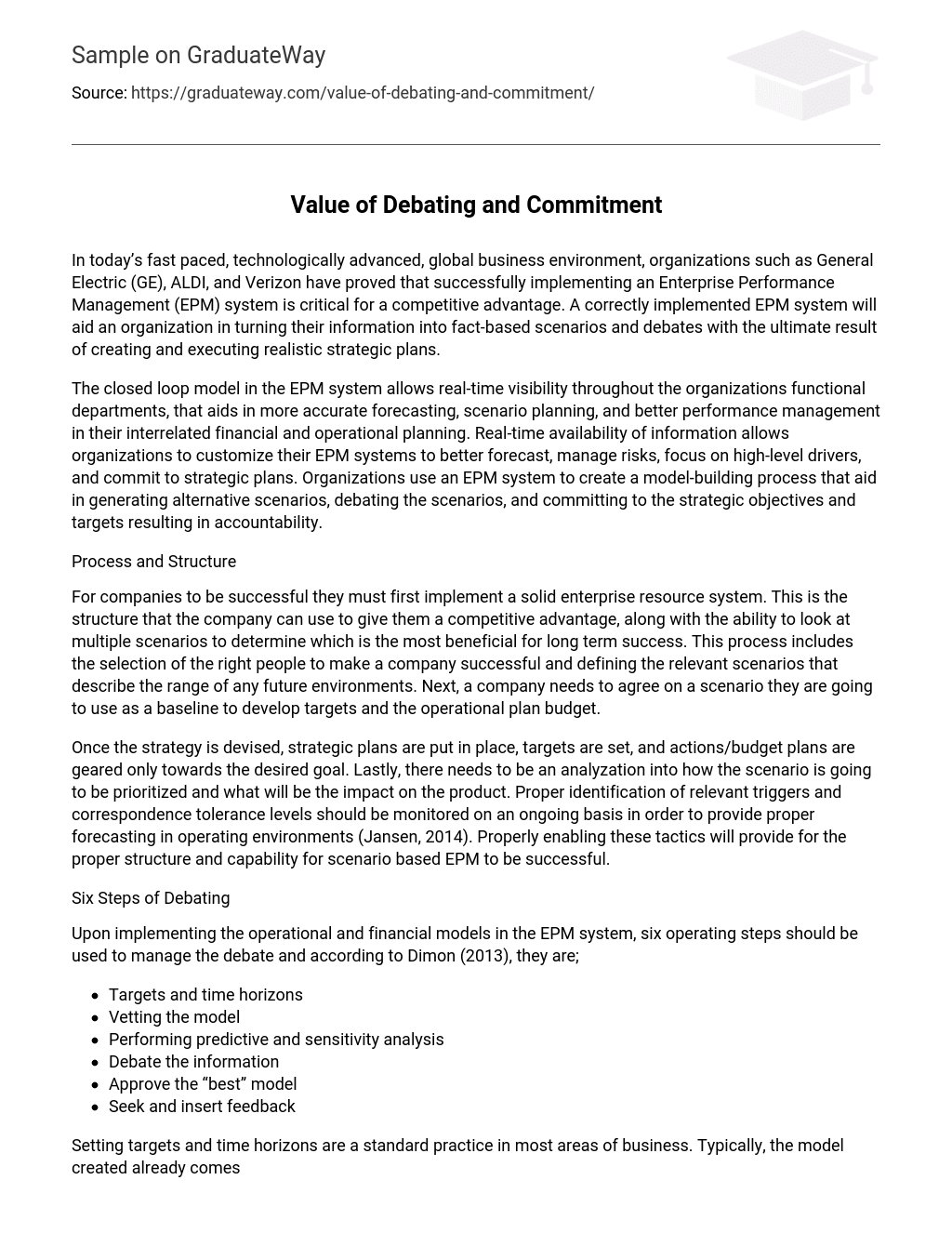In today’s fast paced, technologically advanced, global business environment, organizations such as General Electric (GE), ALDI, and Verizon have proved that successfully implementing an Enterprise Performance Management (EPM) system is critical for a competitive advantage. A correctly implemented EPM system will aid an organization in turning their information into fact-based scenarios and debates with the ultimate result of creating and executing realistic strategic plans.
The closed loop model in the EPM system allows real-time visibility throughout the organizations functional departments, that aids in more accurate forecasting, scenario planning, and better performance management in their interrelated financial and operational planning. Real-time availability of information allows organizations to customize their EPM systems to better forecast, manage risks, focus on high-level drivers, and commit to strategic plans. Organizations use an EPM system to create a model-building process that aid in generating alternative scenarios, debating the scenarios, and committing to the strategic objectives and targets resulting in accountability.
Process and Structure
For companies to be successful they must first implement a solid enterprise resource system. This is the structure that the company can use to give them a competitive advantage, along with the ability to look at multiple scenarios to determine which is the most beneficial for long term success. This process includes the selection of the right people to make a company successful and defining the relevant scenarios that describe the range of any future environments. Next, a company needs to agree on a scenario they are going to use as a baseline to develop targets and the operational plan budget.
Once the strategy is devised, strategic plans are put in place, targets are set, and actions/budget plans are geared only towards the desired goal. Lastly, there needs to be an analyzation into how the scenario is going to be prioritized and what will be the impact on the product. Proper identification of relevant triggers and correspondence tolerance levels should be monitored on an ongoing basis in order to provide proper forecasting in operating environments (Jansen, 2014). Properly enabling these tactics will provide for the proper structure and capability for scenario based EPM to be successful.
Six Steps of Debating
Upon implementing the operational and financial models in the EPM system, six operating steps should be used to manage the debate and according to Dimon (2013), they are;
- Targets and time horizons
- Vetting the model
- Performing predictive and sensitivity analysis
- Debate the information
- Approve the “best” model
- Seek and insert feedback
Setting targets and time horizons are a standard practice in most areas of business. Typically, the model created already comes with set targets and a time frame for completing or analyzing the information. Step two is to vet the model, which includes finding algorithms and monitoring the data with experts to verify and certify it for use. A constant evaluation and adjustment of the debate process circles back to continuous improvement loop to net the best data results from the implemented model.
Predictive analytics and the Monte Carlo simulation is used to show the various outcomes (Palisades, 2020) and the possible models that can be built. The models depend on the system capacity, the selected models, and how quick the models can be created. As any process is put in place, a constant analysis of the information is required. Debating the information and having others test to see if the information has the correct results will validate the model. When all the models are selected and tested, a standard will be put in place as the best for use. As information flows from the model, a constant evaluation and feedback system should be in place. Always analyzing the information to perform optimally for continuous business purposes.
Commit and Accountability
With the assistance of an EPM systm, an organization can bring focus and accountability to their enterprise using the commit process. The inputs and outputs of the commit process consist of drivers and targets, constraints, financial and operational plans, decide and execute, reforecast, adjust, and variance. The high-level drivers and targets are identified and created in the debate process to ensure the workforce executes their performance in ways that will aid in meeting the organizational goals and objectives.
All organizations have constraints (I.e. limited resources such as labor, equipment, and finances), financial and organizational planning aid in identifying constraints to better manage them for continuous improvement. In the EPM, financial and operational planning are interrelated, information is created and shared throughout the entire organization to aid better decision making for all functional areas in a business. The decide and execute process creates the necessary, measurable accountability to execute and achieve set objectives (who is responsible, when is target to be accomplished, and where is the target to be met). For example, organizations use the identified valued drivers and areas of improvement to create balanced scorecards, setting the measurable objectives and targets will meet their goals.
Reforecasting is adjusting plans and forecasts that have changed due to actual results. Adjusting plans, similar to reforecasting, are the results due to actual outcomes and a better understanding of data. The different forms and adjustments made to budgeting, planning, and forecasting will cause the variances in the actions taken by a business. According to Dimon (2013), the goal of planning is to provide an appropriate level of accountability throughout the organization while remaining nimble enough to make resource deployment changes to react to changes in the market (ch6, p100). The commit process fosters accountability and focus throughout the organization by setting specific, measurable, and more informed, accurate standards.
Conclusion
Organizations can gain a competitive advantage by employing an EPM system and utilizing the system properly. The process consists of four main ingredients that work hand-in-hand to create the best possible model for achieving the desired goals. Finance and operating models can continue to get better and evolve through the use of the six management operating steps to guide the debate on them.





